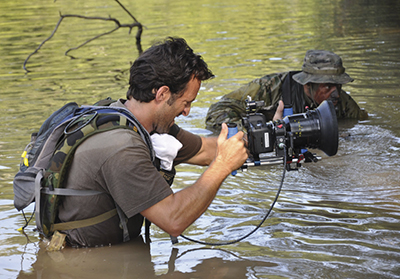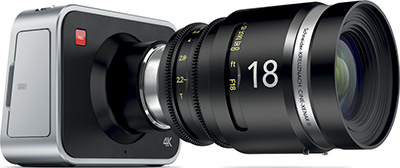Do DSLRs Have a Place in Broadcast?

Shane Hurlbut, the cinematographer on “Act of Valor,” was able to put the Canon 5D DSLR in positions that directors wouldn’t dream of using with a more traditional movie camera.
JOHNSTON, IOWA—Regular readers of Digital Journal know that I am firmly convinced that the value and the future of local broadcasting is in the local station’s ability to acquire and create compelling local content. As the quantity and variety of methods for consumers to consume content increase, the value proposition for being a primarily a carrier of content created by others becomes increasingly more difficult to sustain while still maintaining a credible presence in the local market. So it should come as no surprise that when Iowa Public Television started to look at the digital conversion I championed the idea that we needed to create the best local content we could at the highest quality possible.
We built a facility that is 100 percent high-definition based initially on Sony HDW-700 camcorders and SRW-5500’s and HDW-2000 record decks. We have since migrated to XDCAM utilizing PDW-700 camcorders and PDW-F75 and PDW-U1 decks. When making the transition from tape-based to disc-based media, we also took advantage of the improved video quality offered in the XDCAM system by utilizing the MPEG-HD422 mode codec to acquire content in full 1920x1080 resolution and 24-bit audio as compared to the HDCAM, which was 1440x1080 and 20-bit audio. Because much of our content has a long tail, our focus is always in acquiring at the highest quality possibility.
WHAT ABOUT 4K?
For the last few years I have been looking into what will be our next acquisition transition and started to look at camera systems with 4K and greater imagers. Cameras with these imagers primarily exist in the realm of feature films, but at the SMPTE conference in 2011 I saw a presentation by cinematographer Shane Hurlbut on using the Canon 5D to shoot the majority of the 2012 film “Act of Valor.” The image quality on a large screen was stunning and because of the relatively low cost of the camera, he was able to put them in positions that you wouldn’t dream of using a more traditional movie camera. There is one overhead shot in a room where a live hand grenade is tossed in and you watch it explode. However, the 5D is a DSLR camera and not primarily designed to shoot moving video so they had to essentially turn off a lot of the camera’s features since they were designed to optimize still photography.
At the 2012 NAB Show I stumbled upon the Blackmagic Cinema Camera. Coming from the world of television I confess that it is an odd looking camera when compared to what I am used to seeing but I made note of it primarily because it produced images that were at least as good as anything we have at IPTV and it was priced at just under $3,000. At NAB this year I checked out the Blackmagic Production Camera 4K which has a super 35 imager and utilizes EF or ZE mount lenses. It’s priced at just under $4,000, which puts this camera that is designed to acquire UHD content in the price range of many of the DSLR’s that have added video acquisition to what is essentially a still camera.

Blackmagic Production Camera 4K I don’t think this market is lost on the more traditional DSLR manufacturers. At CES this year I stopped by and looked at a number of DSLR-type cameras that are optimized for their potential role as cinema cameras. Canon has the EOS-1D C, which uses a 18 megapixel imager for better than 4K resolution but the price tag is pretty hefty at about $12,000 and audio recording still looks to be a little behind the curve compared to what I am used to in a dedicated video camera. Last year I borrowed a Nikon D5100 and used it to shoot some high definition video just to get a feel for what it was like. I was quite impressed with the quality of the video, but again, the form factor seemed a little odd. I did stop at Nikon at CES but their focus (pardon the pun) seemed more on their compact still cameras than on their highline DSLR’s entering into the digital cinema world.
I was able to try out both the D7100 and the D800, both of which were extremely comfortable to use. I am probably a throwback, but there is something very comforting about looking through the lens at the image as opposed to looking at the image on a small display mounted on the back of the camera.
The professional video industry's #1 source for news, trends and product and tech information. Sign up below.
A CHANGE IN PERSPECTIVE
So what does this have to do with cameras at IPTV? Last April, one of our PDW-700’s fell off its tripod due to a worn mount. As is the rule, it of course fell lens first to insure maximum damage. The camera body was shipped off to Sony service for evaluation an estimate for the repair. The estimate came back at just over $20,000; a replacement was just under $30,000. Given the age of the camera and the fact that the repair estimate didn’t include any work on the mechanics of the disc system, we opted to go with a new camera body for $30K. This is not a knock on Sony; the industry is changing. But when we think that the same $30,000 would have purchased 10 of the Blackmagic Cinema Camera bodies, it is time to adjust our thinking.
Another epiphany for me came while discussing this topic with my wife. I explained to her that my topic was camcorders and she looked at me and said “when you have kids, you go out and buy one.” At this very moment, new parents are recording home videos using consumer cameras that probably deliver better images than what we are currently acquiring our content with. So it appears to me that the next transitional step in acquisition at IPTV will not only involve better pictures and audio but an adjustment in the type of equipment we use and how we operate it. We may actually be trying to keep up with the Jones.
Bill Hayes is the director of engineering for Iowa Public Television. He can be reached via TV Technology.
Bill Hayes is the former director of engineering and technology for Iowa PBS and has been at the forefront of broadcast TV technology for more than 40 years. He’s a former president of IEEE’s Broadcast Technology Society, is a Partnership Board Member of the International Broadcasting Convention (IBC) and has contributed extensively to SMPTE and ATSC. He is a recipient of Future's 2021 Tech Leadership Award and SMPTE Fellow.

